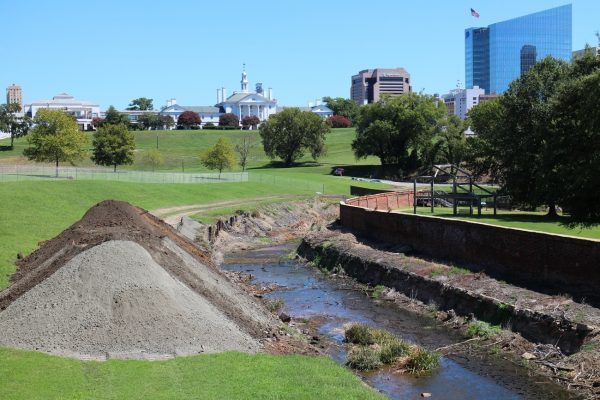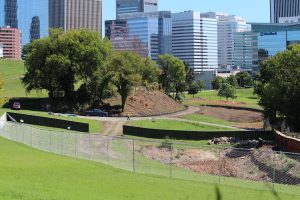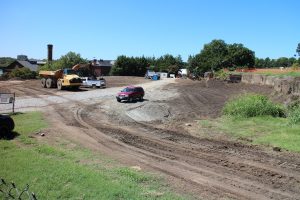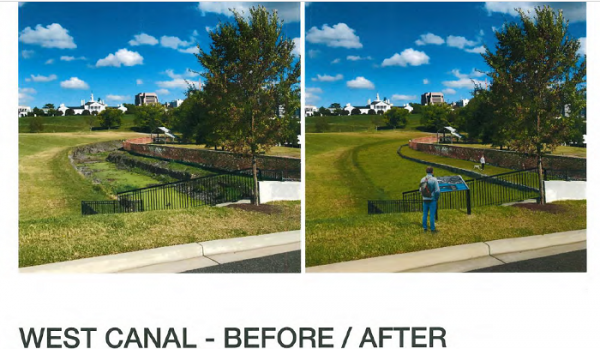
The canal section as it appeared Thursday, with fill dirt placed beside it and NewMarket’s hilltop headquarters visible in the background. (Photos by Jonathan Spiers)
Correction: An earlier version of this story incorrectly stated that NewMarket is a Fortune 500 company. It is in the Fortune 1000.
A local publicly traded company is proceeding with a project that is filling in its portion of a centuries-old canal, using dirt from an adjacent site on its riverfront headquarters that the firm has earmarked for eventual development.
Mounds of fill dirt and fencing placed last week beside the Kanawha Canal behind the Historic Tredegar site signaled the start of the project by NewMarket Corp. to cover and partially fill the portion of the inactive canal that runs through its hillside campus overlooking the James River.

Fencing has been placed around the canal site. Fill dirt covering an eastern section of the canal is visible in the distance.
The project involves covering the section of the canal with a geotechnical fabric and adding fill dirt on top of it, ultimately creating a partially sunken greenway that Bruce Hazelgrove, NewMarket’s chief administrative officer, said is intended to preserve and beautify the site, which plays host to the Richmond Folk Festival and is prone to collecting trash and standing water.
Hazelgrove said the project is needed to stabilize the canal’s nearly 200-year-old stone walls, which he said pose a safety risk to festivalgoers and the public. By lining the canal underneath the fill, he said the walls would be stabilized and could be unearthed if desired later, while in the meantime allowing for safer use and interpretive signage explaining the history of the canal, conceived and developed by George Washington.
Whiting-Turner Contracting Co. is doing the work for NewMarket, using dirt from an adjacent site along South Fifth Street that previously had been used to support Tredegar’s redevelopment as the home of the American Civil War Museum, which leases its property from NewMarket.
Hazelgrove said the Fifth Street site has attracted development interest for years, but he said none of the proposals so far have been the right fit. He said he foresees the site being developed at some point, though not for another several years.

Fill dirt for the project is coming from this site along South Fifth Street, which is earmarked for eventual development.
NewMarket’s land ownership extends across Fifth Street beside the WestRock/CoStar building, which NewMarket developed and owned before selling the building in 2013. Hazelgrove said the vacant land on that side of the street has received interest from hotel developers.
Hazelgrove also acknowledged long-term plans to potentially develop parts of NewMarket’s hillside campus, though he said such activity remains decades away. The acreage is across Second Street from the Virginia War Memorial, where construction on a $26 million expansion has been underway.
Hazelgrove said development interest is not what prompted the canal project, but rather existing concerns over safety and the canal’s structural soundness. Hazelgrove would not say how much the company is investing in the project, which he said has involved digital surveying that revealed wall degradation.
Opposition to project
The project has drawn opposition from some observers, including Jack Pearsall, a local attorney who’s advocated a plan dating to 1988 to return water to the canal, and restore and reconnect it so that boats could run continuously from Haxall Point in Shockoe Slip to as far west as Maymont and potentially beyond.
Pearsall said NewMarket’s project received a permit from the U.S. Army Corps of Engineers without a consultation process requested by him and Historic Richmond. He said they expressed interest in participating in such a process in a letter last fall to Andy Condlin, a Roth Jackson attorney who represented NewMarket on the project.
The letter, dated Oct. 5, 2018, refers to Section 106 of the National Historic Preservation Act, which requires federal agencies such as USACE to consider projects’ effects on historic properties. Pearsall provided a copy of the letter, which was signed by Cyane Crump, executive director, Historic Richmond.
Reached last week, Crump said the letter still reflects Historic Richmond’s position on the project.
In an email, Crump said: “Our primary concern is to minimize the impacts to the existing fabric of historic canal structures, landscape and topography with a goal that any changes to the Canal Project Area be both practically and technically reversible to accommodate a potential future re-watering of the canal and accompanying boat traffic. If a Section 106 process relating to the project is to occur, we welcome the opportunity to participate as a consulting party.”
Pearsall said the canal should be left alone and remain as visible as it is today so people can view it as a historic remnant. He said the only parts of the walls that are unstable are brickwork at the top that would remain visible after the project. Hazelgrove said those sections will be repaired.
“I think it’s a travesty,” Pearsall said. “The idea that they’re improving the canal by burying it just doesn’t make sense. We’ve got a ditch that was dug 150 years ago and it’s in perfect condition, and they want to fill it up.”
Pearsall has been reaching out to the Virginia Department of Historic Resources, which initially agreed with USACE’s finding that the project would have no adverse effects. Alerted by Pearsall that a Section 106 process didn’t play out as he had requested, Roger Kirchen, DHR’s review and compliance division director, said he’s advising that USACE reopen the consultation process, though he noted that it’s USACE’s decision whether to do so.
Hazelgrove said NewMarket has gone above and beyond what’s required for the project in an effort to be transparent, pointing to the meeting a year ago with Condlin, Pearsall and Historic Richmond as an attempt to be proactive and up front about the plan. He maintained that the project is aimed at protecting the canal, reiterating that it could be unearthed and used if such an effort moves forward.
“We think we’ve been good stewards of the site,” Hazelgrove said.

The canal section as it appeared Thursday, with fill dirt placed beside it and NewMarket’s hilltop headquarters visible in the background. (Photos by Jonathan Spiers)
Correction: An earlier version of this story incorrectly stated that NewMarket is a Fortune 500 company. It is in the Fortune 1000.
A local publicly traded company is proceeding with a project that is filling in its portion of a centuries-old canal, using dirt from an adjacent site on its riverfront headquarters that the firm has earmarked for eventual development.
Mounds of fill dirt and fencing placed last week beside the Kanawha Canal behind the Historic Tredegar site signaled the start of the project by NewMarket Corp. to cover and partially fill the portion of the inactive canal that runs through its hillside campus overlooking the James River.

Fencing has been placed around the canal site. Fill dirt covering an eastern section of the canal is visible in the distance.
The project involves covering the section of the canal with a geotechnical fabric and adding fill dirt on top of it, ultimately creating a partially sunken greenway that Bruce Hazelgrove, NewMarket’s chief administrative officer, said is intended to preserve and beautify the site, which plays host to the Richmond Folk Festival and is prone to collecting trash and standing water.
Hazelgrove said the project is needed to stabilize the canal’s nearly 200-year-old stone walls, which he said pose a safety risk to festivalgoers and the public. By lining the canal underneath the fill, he said the walls would be stabilized and could be unearthed if desired later, while in the meantime allowing for safer use and interpretive signage explaining the history of the canal, conceived and developed by George Washington.
Whiting-Turner Contracting Co. is doing the work for NewMarket, using dirt from an adjacent site along South Fifth Street that previously had been used to support Tredegar’s redevelopment as the home of the American Civil War Museum, which leases its property from NewMarket.
Hazelgrove said the Fifth Street site has attracted development interest for years, but he said none of the proposals so far have been the right fit. He said he foresees the site being developed at some point, though not for another several years.

Fill dirt for the project is coming from this site along South Fifth Street, which is earmarked for eventual development.
NewMarket’s land ownership extends across Fifth Street beside the WestRock/CoStar building, which NewMarket developed and owned before selling the building in 2013. Hazelgrove said the vacant land on that side of the street has received interest from hotel developers.
Hazelgrove also acknowledged long-term plans to potentially develop parts of NewMarket’s hillside campus, though he said such activity remains decades away. The acreage is across Second Street from the Virginia War Memorial, where construction on a $26 million expansion has been underway.
Hazelgrove said development interest is not what prompted the canal project, but rather existing concerns over safety and the canal’s structural soundness. Hazelgrove would not say how much the company is investing in the project, which he said has involved digital surveying that revealed wall degradation.
Opposition to project
The project has drawn opposition from some observers, including Jack Pearsall, a local attorney who’s advocated a plan dating to 1988 to return water to the canal, and restore and reconnect it so that boats could run continuously from Haxall Point in Shockoe Slip to as far west as Maymont and potentially beyond.
Pearsall said NewMarket’s project received a permit from the U.S. Army Corps of Engineers without a consultation process requested by him and Historic Richmond. He said they expressed interest in participating in such a process in a letter last fall to Andy Condlin, a Roth Jackson attorney who represented NewMarket on the project.
The letter, dated Oct. 5, 2018, refers to Section 106 of the National Historic Preservation Act, which requires federal agencies such as USACE to consider projects’ effects on historic properties. Pearsall provided a copy of the letter, which was signed by Cyane Crump, executive director, Historic Richmond.
Reached last week, Crump said the letter still reflects Historic Richmond’s position on the project.
In an email, Crump said: “Our primary concern is to minimize the impacts to the existing fabric of historic canal structures, landscape and topography with a goal that any changes to the Canal Project Area be both practically and technically reversible to accommodate a potential future re-watering of the canal and accompanying boat traffic. If a Section 106 process relating to the project is to occur, we welcome the opportunity to participate as a consulting party.”
Pearsall said the canal should be left alone and remain as visible as it is today so people can view it as a historic remnant. He said the only parts of the walls that are unstable are brickwork at the top that would remain visible after the project. Hazelgrove said those sections will be repaired.
“I think it’s a travesty,” Pearsall said. “The idea that they’re improving the canal by burying it just doesn’t make sense. We’ve got a ditch that was dug 150 years ago and it’s in perfect condition, and they want to fill it up.”
Pearsall has been reaching out to the Virginia Department of Historic Resources, which initially agreed with USACE’s finding that the project would have no adverse effects. Alerted by Pearsall that a Section 106 process didn’t play out as he had requested, Roger Kirchen, DHR’s review and compliance division director, said he’s advising that USACE reopen the consultation process, though he noted that it’s USACE’s decision whether to do so.
Hazelgrove said NewMarket has gone above and beyond what’s required for the project in an effort to be transparent, pointing to the meeting a year ago with Condlin, Pearsall and Historic Richmond as an attempt to be proactive and up front about the plan. He maintained that the project is aimed at protecting the canal, reiterating that it could be unearthed and used if such an effort moves forward.
“We think we’ve been good stewards of the site,” Hazelgrove said.




Not a fan of the fill-in of this section. I would love for them to bring the canal back to its former glory and to connect it to the canal walk and browns island to Maymont. Would be a great extension to the capital trail for biking, walking, jogging, tour boat, and historians.
Richmond has really come a long way in becoming a great place for all to enjoy, but it is sad to see that money is more important than the preservation of it’s past. Many cities around our country have done just this and paved over their history and abandoned their character for “new”. This will probably be the first step towards NewMarket making or selling this for something as spectacular as a parking lot.
Well, I guess the decision-maker didn’t make it to the Byrd Theatre’s Environmental Film Fest to watch that one film about “Day-Lighting” and how other cities around the world are uncovering rivers and streams to the benefit of the enviriment, economic, and social uses. Sounds like a cheaper alternative disguised as safety from the legal department. Shocker.
This seems like an awful idea. Filling in the canal should not be allowed. Restoring it would be much better. Shocked a private entity is being allowed to do this.
I’m sorry, but the idea that a private entity is “allowed” to alter their land at their own expense for safety (and even aesthetic) reasons is not shocking. I agree it would be a nice addition to the city to have canal boats navigate the canal from Maymont to Brown’s Island, but there isn’t a business case for it right now. I think that a plan that allows for 1) historical markers to highlight the area’s past, and 2) grading the land in a way that would allow future restoration is a good compromise (seeing that both of which are… Read more »
William, while I generally agree with your thoughts, there are many restrictions on private property, from historical to environmental reasons. Most of them can be overcome, but usually at a significant investment of cost as well as time and effort navigating the regulatory gauntlet. This will only get worse as time goes on. One of the problems here is the geographic limitation. It can’t be replaced in a different location like wetlands are handled. This is a very interesting (and unusual) dilemma.
Agreed, this is a unique case based on its geography. First, on the safety issue, I think its a good idea to fill in the canal – as any injuries would be the sole responsibility of the property owner, not the City, ACOE, or any historic commission. Second, there is a level of historical significance to the site, and that needs to be respected – but the only case for restoring to its former use (as a waterway) is in conjunction with all of the other property owners along the route from Brown’s Island to Maymont – and until there… Read more »
I know I may be in the minority, but as long as they are preserving it in a way that would allow it to be uncovered when a project to extend the canal walk to Maymont had enough money I am a bit ambivalent about it. It is not like they are digging up the stone walls or something. It is going to take a lot of money to connect this to the existing canal walk for boats because of the grade difference and the lack of an existing lock system connecting the two. When the money is there and… Read more »
Sadly this is the same old story — “demolition by decay”. Investors acquire property and let the structures on it deteriorate. Eventually they can claim everything is beyond repair and boast of how they are saving lives by demolishing it.
Not unlike what Stone Brewing did with the Fulton site. Obtain it, let it sit, then say it’s beyond repair.
As possible positives:
I wonder if, in this case, the fill might actually prevent the canal structures from deteriorating further? I’ve read that this is what is done in some archaeological cases. It’s what they did with the Lumpkin’s site, rather than leave it open to the elements (although I’d prefer not to talk about how long *that* has gone without restoration!).
And perhaps by installing historic markers and making it possible for people to walk near and interact with the historic canal site, public awareness may grow about this resource and what could be.
Newmarket, formally Ethyl Corp, has done more to preserve the riverfront and to develop the attractions by the river that so many take for granted than almost anyone else. They have preserved the Tredegar Iron Works, have leased the land that the new Civil War Museum now sits as well as being major financial supporters. They are major supporters of the Folk Festival as well as other events. The canal project will look a lot better than its current state . Reading some responses, some people, if they have been here for any length of time, would have preferred the… Read more »
Christopher, Keep in mind, most people feel the need to complain regardless of the facts or truth. You can’t be for the people if you don’t complain about change regardless of your stance of the day. This is followed closely by suggesting what should be done in one’s opinion with someone else’s private funds….which is my personal favorite type of complaint. My take- I feel we are lucky they at least have the stewardship to preserve it in such a way it can be redeveloped and will sit undisturbed. The last few times I have gone down there for riverrock,… Read more »
The corporations can do whatever they want in the city. Just look at Dominion.